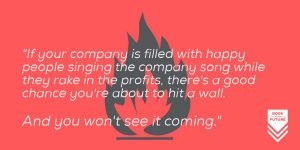Why risk is greatest when you’re happy and profitable

Do you run a happy ship? Does everyone in your organisation sing from the same hymn sheet? Are you all aligned to the same goals? Do these happy staff stay with you for years and years?
Then you’re probably in trouble. Because experience has taught me that these characteristics are often the precursors to a fall.
I’ll explain.
There are two types of organisation that typically call me up for consulting engagements. A small number get in touch when they’re doing well and they want to identify the next opportunity. The majority call me when things are not going so well and they’re looking to get back on track with some insight into where their market or sector is going.
These latter organisations often have much in common. When you interview the management and staff, you find a number of key characteristics:
- Until recently. the organisation has been profitable for a long time — often growing (or in the public sector, funded with a manageable amount of cash, year on year)
- People stay with the organisation a long time — more than seven years — and often trained with that company
- Staff are totally sold on the company message. Apart from the usual gripes (IT, inter-departmental communication, their boss) you hear the same story about the company and the market from everyone
In these circumstances, something happens. Or rather it doesn’t. People don’t ask hard questions. Because they don’t want to risk the comfort of the warm bath they’re in. And because with so little exposure to what’s going on outside, they don’t know which questions to ask.
If you run an organisation that sounds like this one, get help. Bring in someone with a fresh pair of eyes. Get them to take a good, hard, critical look. Listen to what they come back with, and act on it.
Crucially, don’t let this analyst stay involved too long. Six months at most. Longer than that and they will be infected by the good will and happiness. They will lose objectivity and start to believe things like “that won’t affect us” or “that doesn’t work in this market.”
Once this analyst has done your diagnosis and made a prescription, bring in other people to help you make the change. Specialists in people, technology and transformation.
Six months later, bring your analyst back and tell them to look again. Don’t be surprised if they raise new criticisms.
Repeat the process.
In this environment, the only way you keep your organisation happy and profitable, is through constant evolution.
###
Need an analyst to help you see the darkness in your bright and shiny world? You need an Applied Futurist.
Get in touch and we can help you directly, or introduce you to one of our growing number of partners nationwide.
